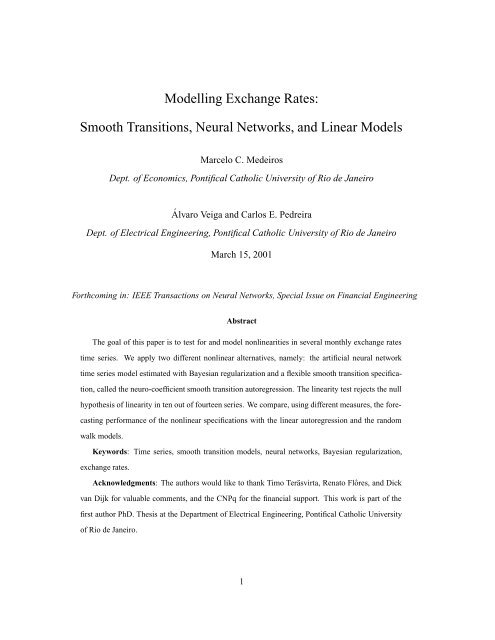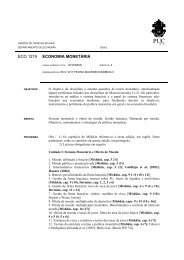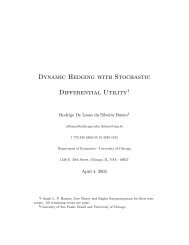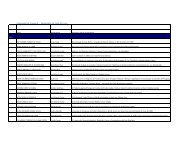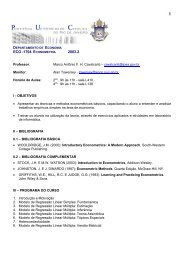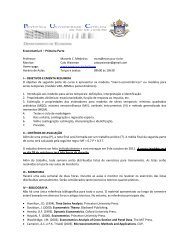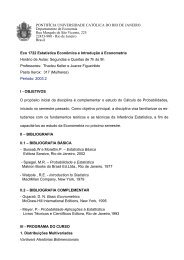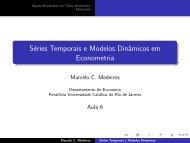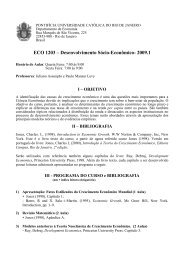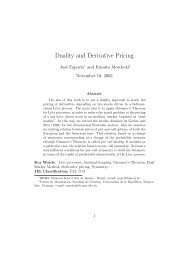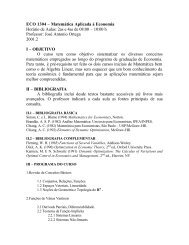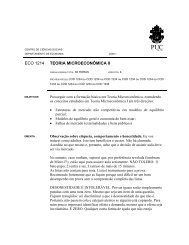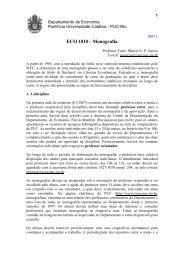Smooth Transitions, Neural Networks, and Linear Models - CiteSeerX
Smooth Transitions, Neural Networks, and Linear Models - CiteSeerX
Smooth Transitions, Neural Networks, and Linear Models - CiteSeerX
Create successful ePaper yourself
Turn your PDF publications into a flip-book with our unique Google optimized e-Paper software.
Modelling Exchange Rates:<strong>Smooth</strong> <strong>Transitions</strong>, <strong>Neural</strong> <strong>Networks</strong>, <strong>and</strong> <strong>Linear</strong> <strong>Models</strong>Marcelo C. MedeirosDept. of Economics, Pontifical Catholic University of Rio de JaneiroÁlvaro Veiga <strong>and</strong> Carlos E. PedreiraDept. of Electrical Engineering, Pontifical Catholic University of Rio de JaneiroMarch 15, 2001Forthcoming in: IEEE Transactions on <strong>Neural</strong> <strong>Networks</strong>, Special Issue on Financial EngineeringAbstractThe goal of this paper is to test for <strong>and</strong> model nonlinearities in several monthly exchange ratestime series. We apply two different nonlinear alternatives, namely: the artificial neural networktime series model estimated with Bayesian regularization <strong>and</strong> a flexible smooth transition specification,called the neuro-coefficient smooth transition autoregression. The linearity test rejects the nullhypothesis of linearity in ten out of fourteen series. We compare, using different measures, the forecastingperformance of the nonlinear specifications with the linear autoregression <strong>and</strong> the r<strong>and</strong>omwalk models.Keywords: Time series, smooth transition models, neural networks, Bayesian regularization,exchange rates.Acknowledgments: The authors would like to thank Timo Teräsvirta, Renato Flôres, <strong>and</strong> Dickvan Dijk for valuable comments, <strong>and</strong> the CNPq for the financial support. This work is part of thefirst author PhD. Thesis at the Department of Electrical Engineering, Pontifical Catholic Universityof Rio de Janeiro.1
1 IntroductionDuring the last two decades many different nonlinear models have been proposed in the literature tomodel <strong>and</strong> forecast exchange rates. Several authors claimed that exchange rates are rather unpredictable,<strong>and</strong> that a r<strong>and</strong>om walk model is often a better predictor than concurrent nonlinear models. See forexample, Chang <strong>and</strong> Osler (1999), Gencay (1999), Meese <strong>and</strong> Rose (1991), <strong>and</strong> Meese <strong>and</strong> Rose (1990).With this concern in mind, some questions should be raised: How relevant is the nonlinearity in theseries? Is the nonlinearity uniformly spread? Are nonlinear models better predictors? If there are periodsof the series with no nonlinearity, what is the lost (if any) of applying a nonlinear model? Without havingthe intention of solving these fundamental <strong>and</strong> complex questions, this paper addresses the problem bybenchmarking two nonlinear alternatives against the linear AutoRegressive (AR) <strong>and</strong> the R<strong>and</strong>om Walk(RW) models. Several monthly exchange rates time series are used. For similar papers, see Sarantis(1999) <strong>and</strong> Qi <strong>and</strong> Wu (to appear).The nonlinear alternatives considered in this paper are the Artificial <strong>Neural</strong> Network (ANN) model(Kuan <strong>and</strong> White 1994) <strong>and</strong> a novel flexible model called the Neuro-Coefficient <strong>Smooth</strong> Transition AutoRegression(NCSTAR) (Medeiros <strong>and</strong> Veiga 2000b). The NCSTAR specification can be interpretedas a linear model where its coefficients are given by a single hidden layer feedforward neural network<strong>and</strong> has the main advantage of nesting several well-known nonlinear formulations, such as, the Self-Exciting Threshold AutoRegression (SETAR) (Tong 1978, Tong <strong>and</strong> Lim 1980), the <strong>Smooth</strong> TransitionAutoRegression (STAR) (Chan <strong>and</strong> Tong 1986, Luukkonen, Saikkonen <strong>and</strong> Teräsvirta 1988, Teräsvirta1994), <strong>and</strong> the ANN model. Furthermore, if the neural network is interpreted as a nonparametric universalapproximation to any Borel-measurable function, the NCSTAR model is directly comparable to theFunctional Coefficient AutoRegression (FAR) (Chen <strong>and</strong> Tsay 1993) <strong>and</strong> the Single-Index CoefficientRegression model (Xia <strong>and</strong> Li 1999). A modelling strategy for the NCSTAR model was developed inMedeiros <strong>and</strong> Veiga (2000a) <strong>and</strong> Medeiros <strong>and</strong> Veiga (to appear).The plan of the paper is as follows. Section 2 discusses the NCSTAR model <strong>and</strong> briefly describesthe modelling strategy. Section 3 outlines the neural network models with Bayesian regularization. Thebenchmark models are described in Section 4. Section 5 gives a description of an experiment comparingthe forecasting performance of the NCSTAR <strong>and</strong> the neural network models with the benchmark2
alternatives. The results are discussed in Section 6. Finally, Section 7 concludes.2 The NCSTAR Model2.1 Mathematical FormulationConsider a linear model with time-varying coefficients expressed asÝ Ø ¼ Ø Þ Ø · Ø (1)where Ø ´¼µØ´½µØ´ÔµØ ℄ ¼ is a vector of real coefficients <strong>and</strong> Þ Ø ½ Þ ¼ Ø ℄¼ . Þ Ø ¾ Ê Ô is a vectorof lagged values of Ý Ø <strong>and</strong>/or some exogenous variables. The r<strong>and</strong>om term Ø is a normally distributedwhite noise with variance ¾ . The time evolution of the coefficients ´µØof (1) is given by´µØ½ ´ ¼ Ü Ø ¬ µ ¼ ¼ ¡¡¡ Ô (2)where <strong>and</strong> ¼ are real coefficients.The function ´ ¼ Ü Ø¬ µ is the logistic function, where Ü Ø ¾ Ê Õ is a vector of input variables, ½ Õ ℄ ¼ <strong>and</strong> ¬ are real parameters . The norm of is called the slope parameter. In thelimit, when the slope parameter approaches infinity, the logistic function becomes a step function.Note that (1) can be interpreted as a linear model where its coefficients are given by a single hiddenlayer feedforward neural network.The neural network architecture representing (2) is illustrated inFigure 1. The elements of Ü Ø , called the transition variables, can be formed by lagged values of Ý Ø <strong>and</strong>/orany exogenous variables. In this paper, we assume that Ü Ø is formed by a subset of the elements of Þ Ø<strong>and</strong> that there are no exogenous variables in the model specification.Equations (1) <strong>and</strong> (2) represent a time-varying model with a multivariate smooth transition structuredefined by hidden neurons.[FIGURE 1 SOMEWHERE HERE]3
Equation (1) can be rewritten asÝ Ø ´Þ Ø Ü Ø ©µ · Ø « ¼ ··Ô½« Ý Ø ·´ Ô ½ ½½ ¼ ´ ¼ Ü Ø ¬ µ ´ ¼ Ü Ø ¬ µµÝ Ø · Ø (3)or in vector notationÝ Ø ´Þ Ø Ü Ø ©µ · Ø « ¼ Þ Ø ·½ ¼ Þ Ø ´ ¼ Ü Ø ¬ µ· Ø (4)where © « ¼ ¼ ½ ¼ ¼ ½ ¼ ¬ ½¬ ℄ ¼ is a parameter vector with ´Õ ·½µ¢ ·´Ô ·½µ¢´ ·½µelements, « « ¼ « Ô ℄ ¼ ¼¼ Ô¼ ℄ ¼ , <strong>and</strong> ¼ Ô ℄ ¼ .Note that model (4) is, in principle, neither globally nor locally identified. To ensure the identifiabilityof (4) we have to impose the following restrictions: ¬ ½ ¬ <strong>and</strong> ½ ¼, ½. Fordetails on identifiability concepts see, e. g., Sussman (1992), Kurková <strong>and</strong> Kainen (1994), Hwang <strong>and</strong>Ding (1997), Anders <strong>and</strong> Korn (1999), Trapletti, Leisch <strong>and</strong> Hornik (2000), <strong>and</strong> Medeiros <strong>and</strong> Veiga(2000a).The NCSTAR model has the main advantage of nesting several well-known nonlinear formulations,such as, for example, the SETAR, STAR, <strong>and</strong> ANN models.2.2 Modelling CycleIn this section, we briefly outline a modelling technique based on statistical inference to build the NC-STAR model. For more details, see Medeiros <strong>and</strong> Veiga (2000a) <strong>and</strong> Medeiros <strong>and</strong> Veiga (to appear).This amounts to proceeding from a linear model to the smallest NCSTAR model <strong>and</strong> gradually towardslarger ones through a sequence of Lagrange Multiplier (LM) tests. Finally, after the model has beenestimated, it is evaluated by some misspecification tests. For similar ideas, see Tsay (1989), Teräsvirta(1994), <strong>and</strong> Eitrheim <strong>and</strong> Teräsvirta (1996). The modelling cycle can be summarized as follows:1. Specification(a) Select the variables of the model.4
(b) Test linearity.(c) If linearity is rejected, determine the number of hidden units.2. Parameter estimation of the specified model.3. Model evaluation based on misspecification testing.(a) Test for parameter constancy.(b) Test for serial independence of the error term.(c) Test for homoscedasticity of the error term .These three stages are briefly described below.2.2.1 Specification2.2.1.1 Variable Selection. The first step of the specification stage is to select the variables of themodel. In this step we will not distinguish between the variables in Þ Ø <strong>and</strong> Ü Ø in (4). Following Medeiros<strong>and</strong> Veiga (2000a), we adopt the simple procedure proposed by Rech, Teräsvirta <strong>and</strong> Tschernig (1999).Their proposal uses global parametric least squares estimation <strong>and</strong> is based on a polynomial expansionof the model. We provide a brief overview of the method. For more details see Rech et al. (1999).Consider model (4). The first step is to exp<strong>and</strong> function ´Þ Ø Ü Ø ©µ into a -order polynomialexpansion around an arbitrary fixed point in the sample space. After merging terms, one obtains´Þ Ø Ü Ø ©µ ¼ Þ Ø ··ÔÔ Ô ½ ½¡¡¡ ½ ½ ½ ¾ ½ ½ ¾Þ ½ ØÞ ¾ Ø · Ô ½ Þ ½ Ø ¡¡¡Þ Ø · Ê´Þ Ø Ü Ø ©µ(5)where Ê´Þ Ø Ü Ø ©µ is the remainder <strong>and</strong> the ¼ ×, ¼ ×, <strong>and</strong> ¾ Ê Ô·½ are parameters. Note that the termsinvolving Ü Ø merged with the terms involving Þ Ø .The second step is to regress Ý Ø on all variables in the polynomial expansion <strong>and</strong> compute the valueof a model selection criterion, such as, for example, the Akaike’s information criterion (AIC). After that,remove one variable from the original model <strong>and</strong> regress Ý Ø on all the remaining terms in the expansion5
<strong>and</strong> compute the value of the AIC. Repeat this procedure by omitting each variable in turn. Continue bysimultaneously omitting two regressors of the original model <strong>and</strong> proceed in that way until the polynomialexpansion becomes a function of a single regressor. Choose the combination of variables that yieldsthe lowest value of the AIC. The selected variables will compose the vector Þ Ø .2.2.1.2 Testing <strong>Linear</strong>ity. In practical nonlinear time series modelling, testing linearity plays an importantrole. In the context of model (4), testing linearity has two objectives. The first one is to verify ifa linear model is able to adequately describe the data generating process. The second one refers to thevariable selection problem. The linearity test is used to determine the elements of Ü Ø . After selecting theelements of Þ Ø with the procedure described above, we choose the elements of Ü Ø by running the linearitytest described below setting Ü Ø equal to each possible subset of the elements of Þ Ø <strong>and</strong> choosing the onethat minimize the Ô-value of the test.In order to test for linearity, equation (4) is rewritten asÝ Ø « ¼ Þ Ø ·½ ¼ Þ Ø ´ ´ ¼ Ü Ø µµ · Ø (6)where , , <strong>and</strong> ¬ , ½. The transition function ´ ´ ¼ Ü Ø µµis redefined as ´ ´ ¼ Ü Ø µµ ½½·exp´ ´ ¼ Ü Ø µµ½¾ (7)Subtracting one-half from the logistic function is useful just in deriving linearity tests where it simplifiesnotation but not affect the argument. The models estimated in this paper do not contain that term.Consider (6) with (7) <strong>and</strong> the testing of the hypothesis that Ý Ø is a linear process. Note that ´¼µ ¼,implying the null hypothesis of linearityH ¼ ¼ ½ (8)Hypothesis (8) offers a convenient starting point for studying the linearity problem in the LM (score)testing framework.Note that model (6) is not identified under the null. A consequence of this complication is that6
the st<strong>and</strong>ard asymptotic distribution theory for the likelihood ratio or other classical test statistics fortesting (8) is not available. We solve the problem by replacing ´ ´ ¼ Ü Ø µµ by a third order Taylorexpansion approximation about ¼, ½.After rearranging terms, we getÝ Ø ¼ Þ Ø ···Ô ÕÕÕÕ½ Õ½ ½ Ô ÕÕÕ½ ½ Ð Ü Ø Ü Ø ·¬ Þ £ Ø Ü ØÜ Ø ·ÕÔ ÕÕ½ ½Õ¬ Þ £ ØÜ Ø ·ÕÕÕÕ ÕÕ½ Ð Ü Ø Ü Ø Ü Ø Ü ÐØ Ü Ø Ü Ø Ü Ø(9)½ Ь Ð Þ Ø £ Ü ØÜ Ø Ü ÐØ · £ Ø where £ Ø Ø · Ê´Þ Ø Ü Ø ©µ. Ê´Þ Ø Ü Ø ©µ is the combined remainder of the third-order Taylor expansionof the logistic functions. The vector Þ £ Ø ¾ ÊÔ Õ is formed by the elements of Þ Ø that are not in Ü Ø .The null hypothesis is defined as H ¼ ¼, ¬ ¼, ¼, ¬ ¼, Ð ¼, <strong>and</strong> ¬ Ð ¼.From (9) it is seen that the test is just a test of a linear hypothesis in a linear model, so that st<strong>and</strong>ardasymptotic inference is available.It is important to stress that the linearity test against a STAR model (Teräsvirta 1994) <strong>and</strong> the neuralnetwork linearity test (Teräsvirta, Lin <strong>and</strong> Granger 1993) are special cases of the test discussed here.2.2.1.3 Determining the Number of Hidden Units. In a practical situation one wants to be able totest for the number of hidden units of the neural network. The basic idea is to start using the linearitytest described above <strong>and</strong> test the linear model against the nonlinear alternative with only one hidden unit.If the linearity is rejected, then fit a model with one hidden unit <strong>and</strong> test for the second one. Proceed inthat way until the first acceptance of the null hypothesis. The individual tests are based on linearizingthe nonlinear contribution of the additional hidden neuron. Consider the general case in which the modelcontains hidden units, <strong>and</strong> we want to know whether an additional unit is required or not. Write themodel asÝ Ø « ¼ Þ Ø ·½ ¼ Þ Ø ´ ´ ¼ Ü Ø µµ · ´ ·½´ ¼ ·½ Ü Ø ·½ µµ · Ø (10)7
An appropriate null hypothesis isH ¼ ·½ ¼ (11)Note that (10) is only identified under the alternative. Using a third order expansion <strong>and</strong> after rearrangingterms, the resulting model isÝ Ø ¼ Þ Ø ····ÕÕ½ Ô ÕÕ½½ ½ Ô ÕÕ ¼ Þ Ø ´ ´ ¼ Ü Ø µµ Ü Ø Ü Ø ·ÕÕÔ ÕÕ½ ½¬ Þ £ ØÜ Ø Ü Ø ·Õ½ ½ Ь Þ £ ØÜ Ø ·Õ ÕÕ½ Ь Ð Þ £ ØÜ Ø Ü Ø Ü ÐØ · £ Ø Õ ÕÕ½ Õ Ü Ø Ü Ø Ü Ø Ð Ü Ø Ü Ø Ü Ø Ü ÐØ(12)The null hypothesis is defined as H ¼ ¼¬ ¼ ¼. Again, st<strong>and</strong>ard asymptoticinference is available.2.2.2 Parameter EstimationAfter specifying the model, the parameters should be estimated by nonlinear least squares (NLS). Hencethe parameter vector © of (4) is estimated as© argmin© É Ì ´©µ argmin©Ìؽ´Ý Ø ´Þ Ø Ü Ø ©µµ ¾ (13)Under some regularity conditions the estimates are consistent <strong>and</strong> asymptotically normal (Davidson <strong>and</strong>MacKinnon 1993).The estimation procedure is carried together with the test for the number of hidden units. First we testfor linearity against a model given by (4) with ½. If linearity is rejected we estimate the parametersof the nonlinear model <strong>and</strong> test for the second hidden unit. If the null hypothesis is rejected, we use theestimated values for the first hidden unit as starting values <strong>and</strong> use the procedure described in Medeiros<strong>and</strong> Veiga (2000a) to compute initial values for the second hidden unit. We proceed in that way until thefirst acceptance of the null hypothesis.8
2.2.3 Model EvaluationAfter the NCSTAR model has been estimated it has to be evaluated. This means that the assumptionsunder which the model has been estimated have to be checked. These assumptions include the hypothesisof no serial correlation, parameter constancy, <strong>and</strong> homoscedasticity.Testing for normality is also acommon practice in econometrics. In this paper we use the tests discussed in Medeiros <strong>and</strong> Veiga (toappear). They are Lagrange multiplier (LM) type tests of parameter constancy against the alternativeof smoothly changing ones, of serial independence of the error term, <strong>and</strong> homoscedasticity against thehypothesis that the variance smoothly changes between regimes. To test for normality we use the Jarque-Bera test (Jarque <strong>and</strong> Bera 1987).3 Artificial <strong>Neural</strong> <strong>Networks</strong> <strong>and</strong> Bayesian RegularizationA feedforward Artificial <strong>Neural</strong> Network (ANN) time series model can be defined asÝ Ø ´Þ Ø ©µ ¼ ·½ ´ ¼ Þ Ø ¬ µ· Ø (14)where ¼ Õ ℄ ¼ <strong>and</strong> ½ Ô ℄ ¼ are vectors of real parameters, Þ Ø ½ Þ ¼ Ø ℄¼ , Þ Ø ¾ Ê Ôis a vector of lagged values of Ý Ø , Ø is assumed to be a sequence of independent, normally distributedr<strong>and</strong>om variables with zero mean <strong>and</strong> finite variance, <strong>and</strong> ´ ¼ Þ Ø¬ µ is the logistic function. Note thatmodel (14) is just a special case of the NCSTAR model.In this paper we adopt the regularization approach to estimate the ANN models. The fundamentalidea is to find a balance between the number of parameters <strong>and</strong> goodness of fit by penalizing large models.The objective function is modified in such a way that the estimation algorithm effectively prunes thenetwork by driving irrelevant parameter estimates to zero during the estimation process. The parametervector © is estimated as© argminÉ © Ì ´©µ argmin© ´É Ì ´©µ ·´½ µÉ £ Ì ´©µµ (15)where É Ì ´©µ È Ìؽ ´Ý Ø´Þ Ø ©µµ ¾ , É £ Ì ´©µ is the regularization or penalty term, <strong>and</strong> ¼ is9
often called the decay constant. The usual penalty is the sum of squared parametersÉ £ Ì ´©µ Ô ¾ ·¬ ¾ ·Ô¼ ½ ½ ½ ¾ (16)The forecasting ability of the ANN model can depend crucially on the decay constant , especiallywith small in-sample periods. If is too large, the network may still overfit, <strong>and</strong> if it is too small, theANN model does not have an adequate fit in the estimation period. Usually, different types of parametersin the ANN model will usually require different decay constants for good forecasting ability.One approach to determine the optimal regularization parameter is the Bayesian framework ofMacKay (1992), where the parameters of the network are assumed to be r<strong>and</strong>om variables with wellspecifieddistributions. The regularization parameters are related to the unknown variances associatedwith these distributions <strong>and</strong> can be estimated with statistical techniques. Foresee <strong>and</strong> Hagan (1997)give a detailed discussion of the use of Bayesian regularization in combination with the Levenberg-Marquardt optimization algorithm. The main advantage of this method is that even if the ANN model isover-parametrized, the irrelevant parameter estimates are likely to be close to zero <strong>and</strong> the model behaveslike a small network.All the ANN models in this paper are estimated with Bayesian regularization in combination withthe Levenberg-Marquardt algorithm. The starting-values for the parameters are selected by the Nguyen-Widrow rule (Nguyen <strong>and</strong> Widrow 1990).4 Benchmark <strong>Models</strong>In this section we outline two simple linear models that are often used as benchmark formulations in thefinancial time series literature.4.1 The R<strong>and</strong>om Walk ModelConsider the following R<strong>and</strong>om Walk (RW) model for the level of the exchange rate seriesÔ Ø « · Ô Ø ½ · Ù Ø (17)10
where Ô Ø is the price at the time instant Ø, « is a constant, <strong>and</strong> Ù Ø is a r<strong>and</strong>om term identically distributed.Taking the first difference of the logarithms, the resulting model becomesÝ Ø ÐÒ´Ô Ø µ ÐÒ´Ô Ø ½ µ · Ø (18)where Ý Ø is the return at time Ø <strong>and</strong> is a constant. Usually Ø is assumed to be a normally distributedr<strong>and</strong>om variable with zero mean <strong>and</strong> finite variance.4.2 The <strong>Linear</strong> Autoregressive ModelA linear autoregressive (AR) model of order Ô for the returns is defined asÝ Ø « ¼ · « ½ Ý Ø ½ · ¡¡¡· « Ô Ý Ø Ô · Ø (19)where « ¼ « ½ « Ô are real coefficients <strong>and</strong> Ø is a identically normally distributed r<strong>and</strong>om variablewith zero mean <strong>and</strong> finite variance. The order of the model is determined by inspection of the autocorrelation<strong>and</strong> partial autocorrelation functions (ACF <strong>and</strong> PACF).5 The ExperimentTo assess the practical usefulness of the NCSTAR <strong>and</strong> ANN models in comparison with the linear AR<strong>and</strong> RW models <strong>and</strong> to address the questions proposed in the Introduction, an experiment with 14 differentmonthly exchange rates time series is conducted. We have decided to work with monthly timeseries just to avoid to model any ARCH effect in the conditional variance of the series. It is well knownthat daily exchange rates are more volatile than the monthly ones <strong>and</strong>, of course, will have more nonlinearityto model. The data are summarized in Table 1. The series were obtained from Economagic(www.economagic.com).[TABLE 1 SOMEWHERE HERE]Both in-sample <strong>and</strong> out-of-sample performance are considered. The first step is to test linearity in allseries. We discard all the series that do not have evidence of nonlinearity according to the test described11
in Section 2.2.1.2. For the series that turn out to be nonlinear we proceed estimating linear <strong>and</strong> nonlinearmodels, each of which are evaluated according to their in-sample explanatory power <strong>and</strong> out-of-sampleforecasting ability. The forecasts made by each estimated model are compared according to the followingstatistics (described in Appendix A): nRMSE, MAE, MAD, <strong>and</strong> SIGN.The forecasting experiment can be viewed of consisting of the following steps.1. Split the sample into two subsamples: the estimation set (Ø ½Ø ¼ ) <strong>and</strong> the forecasting set(Ø Ø ¼ ·½Ì).2. Estimate the parameters of each model using only the estimation set <strong>and</strong> analyse the in-sampleperformance of the estimated models.3. For Ø Ø ¼ Ì , compute the out-of-sample forecasts of 1- to 4-step-ahead, Ý Ø·Ø , <strong>and</strong> theassociated forecast errors denoted by Ø·Ø , where is the forecasting horizon. Multi-step forecastsfor the nonlinear models are obtained by Monte-Carlo simulation as described in AppendixB4. For each forecasting horizon, compute different performance measures.6 Results6.1 Specification <strong>and</strong> EstimationUsing the variables selected by the AIC <strong>and</strong> the linearity test described in Section 2.2.1.2, evidenceof nonlinearity was found in ten series: Austria, Belgium, Finl<strong>and</strong>, France, Germany, Sweden, Spain,India, Siri Lanka, <strong>and</strong> Australia. However, linearity was strongly rejected only in Finl<strong>and</strong>, Australia, SiriLanka, <strong>and</strong> India. The results are summarized in Table 2.[TABLE 2 SOMEWHERE HERE]To check if the nonlinearity is uniformly spread over the in-sample period, we fix the specificationof Þ Ø <strong>and</strong> Ü Ø <strong>and</strong> test linearity in a rolling window with 100 observations. The Ô-value of the linearitytest for each sub-sample is shown in Figure 2. With the exception of the Siri Lanka, nonlinearity is only12
significant in a few number of periods, specially in the beginning or in the end of the series. This isan interesting result <strong>and</strong> explains why linearity is not strongly rejected for most of the series consideredhere.[FIGURE 2 SOMEWHERE HERE]For those series that turned out to be nonlinear, we continue estimating the models.The specification <strong>and</strong> estimation results for the NCSTAR models can be found in Table 3. This tableshows, for each series, the estimated number of hidden units (), the Ô-value of the LM test of serialcorrelation of order Ö in the residuals (ÄÅ ´Öµ), the Ô-value of the LM test of parameter constancy(ÄÅ Ô ), the Ô-value of the LM test of homocedasticity (ÄÅ ), the Ô-value of the Jarque-Bera (JB) testof normality of the residuals, <strong>and</strong>, finally, the estimated residual st<strong>and</strong>ard deviation.Analysing the results in Table 3, we observe that all the estimated models have uncorrelated errors at0.01 level. Only Sweden <strong>and</strong> Australia have evidence of serial correlated errors (of order 1) at 0.05 level.The hypothesis of parameter constancy is rejected at 0.05 level but not at 0.01 level for France <strong>and</strong> Australia.The only case where the null hypothesis of homoscedasticity is rejected (at 0.05 level) is France.Due the fact that the null hypothesis of serial independence, parameter constancy, <strong>and</strong> homoscedasticityare not strongly rejected (see the Ô-values of the tests) we do not take this into account <strong>and</strong> we accept theestimated models as our final specifications. Figure 3 shows, for each model, the scatter plot of the transitionfunction versus the linear combination of transition variables. With few exceptions, the transitionsbetween regimes are rather smooth.[FIGURE 3 SOMEWHERE HERE]The specification <strong>and</strong> estimation results for the AR models are shown in Table 4. The columns show,respectively, the selected lags, the Ô-value of the Ljung-Box test of order 1,2, <strong>and</strong> 6, the Ô-value of theJarque-Bera (JB) test of normality of the residuals, <strong>and</strong> the estimated residual st<strong>and</strong>ard deviation.Observing Table 4, we note that all the linear models have uncorrelated errors.In Table 5 we show the lags in the ANN models, the number of hidden units, the minimum value ofthe absolute correlation between the outputs of the hidden units of the estimated ANN models, <strong>and</strong> theresidual st<strong>and</strong>ard deviation.13
Observing Tables 7 <strong>and</strong> 8, we conclude that, in most of the series, the differences in the forecastperformance between NCSTAR, ANN, AR, <strong>and</strong> RW models are not significant according to the Diebold-Mariano test. It is important to notice that the NCSTAR model is better than the AR <strong>and</strong> ANN specificationswhen the Siri-Lanka series is considered. This is not surprising, because that is the only serieswhere the nonlinearity is uniformly spread. It is also important to observe that for 1-step-ahead forecasts<strong>and</strong> specially when the MAE is used as a comparison criterion, the results are quite supportive in favourof the linear <strong>and</strong> nonlinear specifications against the naïve RW model.[TABLE 6 SOMEWHERE HERE][TABLE 7 SOMEWHERE HERE][TABLE 8 SOMEWHERE HERE]7 ConclusionsThis paper has presented <strong>and</strong> compared different alternatives to model <strong>and</strong> forecast monthly exchangerates time series. The models that have been used are the Neuro-Coefficient <strong>Smooth</strong> Transition AutoRegressive(NCSTAR) model, Artificial <strong>Neural</strong> <strong>Networks</strong> (ANN), linear AutoRegression (AR), <strong>and</strong>, theR<strong>and</strong>om Walk (RW) formulation.In conclusion, we can now answer the questions raised in the Introduction. How relevant is nonlinearityin the series? Nonlinearity is only relevant in some periods of the series, specially in the beginningor in the end of the sample. Is the nonlinearity uniformly spread? No, with the exception of the Siri-Lanka, the nonlinearity is concentrated in only a small sub-sample of the data. Are nonlinear modelsbetter predictors? Nonlinear models st<strong>and</strong> a better chance only in the cases where nonlinearity is uniformlyspread. Otherwise, there is no significant differences in the forecasts made by a concurrent linearmodel. What is the lost (if any) of applying a nonlinear alternative when there is no evidence of nonlinearity?If a statistical procedure to build nonlinear models is used, probably the final estimated modelwill be close to a linear specification <strong>and</strong> the forecasting ability will be close to the one from a linearspecification. In this paper we have used a statistical approach to build the NCSTAR model <strong>and</strong> the ANNformulations have been estimated with Bayesian regularization that tries to build a parsimonious model15
ased on Bayesian fundamentals. Concerning the predictability of exchange rates, we conclude that for1-step-ahead forecasts <strong>and</strong> when the MAE is used as a performance metric, there are some supportiveresults in favor of linear <strong>and</strong> nonlinear models against the simple r<strong>and</strong>om walk.ReferencesAnders, U. <strong>and</strong> Korn, O. (1999). Model selection in neural networks, <strong>Neural</strong> <strong>Networks</strong> 12: 309–323.Chan, K. S. <strong>and</strong> Tong, H. (1986). On estimating thresholds in autoregressive models, Journal of TimeSeries Analysis 7: 179–190.Chang, P. H. K. <strong>and</strong> Osler, C. L. (1999). Methodical madness: Technical analysis <strong>and</strong> the irrationality ofexchange-rate forecasts, Economic Journal 10: 636–661.Chen, R. <strong>and</strong> Tsay, R. S. (1993). Functional coefficient autoregressive models, Journal of the AmericanStatistical Association 88: 298–308.Davidson, R. <strong>and</strong> MacKinnon, J. G. (1993). Estimation <strong>and</strong> Inference in Econometrics, Oxford UniversityPress, New York, NY.Diebold, F. X. <strong>and</strong> Mariano, R. S. (1995).Comparing predictive accuracy, Journal of Business <strong>and</strong>Economic Statistics 13: 253–263.Eitrheim, Ø. <strong>and</strong> Teräsvirta, T. (1996). Testing the adequacy of smooth transition autoregressive models,Journal of Econometrics 74: 59–75.Foresee, F. D. <strong>and</strong> Hagan, M. . T. (1997). Gauss-newton approximation to Bayesian regularization, IEEEInternational Conference on <strong>Neural</strong> <strong>Networks</strong> (Vol. 3), IEEE, New York, pp. 1930–1935.Gencay, R. (1999). <strong>Linear</strong>, non-linear <strong>and</strong> essential foreign exchange rate prediction with simple technicaltrading rules, Journal of International Economics 47: 91–107.Granger, C. W. J. <strong>and</strong> Teräsvirta, T. (1993).Modelling Nonlinear Economic Relationships, OxfordUniversity Press, Oxford.16
Harvey, D., Leybourne, S. <strong>and</strong> Newbold, P. (1997). Testing the equality of prediction mean squarederrors, International Journal of Forecasting 13: 281–291.Hwang, J. T. G. <strong>and</strong> Ding, A. A. (1997). Prediction intervals for artificial neural networks, Journal of theAmerican Statistical Association 92(438): 109–125.Jarque, C. M. <strong>and</strong> Bera, A. K. (1987). A test of normality of observations <strong>and</strong> regression residuals,International Statistical Review 55: 163–172.Kuan, C. M. <strong>and</strong> White, H. (1994). Artificial neural networks: An econometric perspective, EconometricReviews 13: 1–91.Kurková, V. <strong>and</strong> Kainen, P. C. (1994). Functionally equivalent feedforward neural networks, <strong>Neural</strong>Computation 6: 543–558.Luukkonen, R., Saikkonen, P. <strong>and</strong> Teräsvirta, T. (1988).Testing linearity against smooth transitionautoregressive models, Biometrika 75: 491–499.MacKay, D. J. C. (1992). Bayesian interpolation, <strong>Neural</strong> Computation 4: 415–447.Medeiros, M. C. <strong>and</strong> Veiga, A. (2000a). A hybrid linear-neural model for time series forecasting, IEEETransactions on <strong>Neural</strong> <strong>Networks</strong> 11(6): 1402–14012.Medeiros, M. C. <strong>and</strong> Veiga, A. (2000b).A flexible coefficient smooth transition time series model,Working Paper Series in Economics <strong>and</strong> Finance 361, Stockholm School of Economics.Medeiros, M. C. <strong>and</strong> Veiga, A. (to appear). Diagnostic checking in a flexible nonlinear time series model,Journal of Time Series Analysis.Meese, R. A. <strong>and</strong> Rose, A. K. (1990). Nonlinear, nonparametric, nonessential exchange rate estimation,American Economic Review Papers <strong>and</strong> Proceedings 80: 192–196.Meese, R. A. <strong>and</strong> Rose, A. K. (1991). An empirical assessment of nonlinearities in models of exchangerate determination, Review of Economic Studies 58: 603–619.17
Nguyen, D. <strong>and</strong> Widrow, B. (1990). Improving the learning speed of 2-layer neural networks by choosinginitial values of the adaptive weights, Proceedings of the International Joint Conference on <strong>Neural</strong><strong>Networks</strong>, Vol. 3, pp. 21–26.Qi, M. <strong>and</strong> Wu, Y. (to appear). Exchange rates <strong>and</strong> fundamentals: Evidence from ou-of-sample forecastingusing neural networks, Computational Finance 1999, The MIT Press.Rech, G., Teräsvirta, T. <strong>and</strong> Tschernig, R. (1999). A simple variable selection technique for nonlinearmodels, Working Paper Series in Economics <strong>and</strong> Finance 296, Stockholm School of Economics.Sarantis, N. (1999). Modeling non-linearities in real effective exchange rates, Journal of InternationalMoney <strong>and</strong> Finance 18(1): 27–45.Sussman, H. J. (1992). Uniqueness of the weights for minimal feedforward nets with a given input-outputmap, <strong>Neural</strong> <strong>Networks</strong> 5: 589–593.Teräsvirta, T. (1994). Specification, estimation, <strong>and</strong> evaluation of smooth transition autoregressive models,Journal of the American Statistical Association 89(425): 208–218.Teräsvirta, T., Lin, C. F. <strong>and</strong> Granger, C. W. J. (1993). Power of the neural network linearity test, Journalof Time Series Analysis 14(2): 309–323.Tong, H. (1978). On a threshold model, in C. H. Chen (ed.), Pattern Recognition <strong>and</strong> Signal Processing,Sijthoff <strong>and</strong> Noordhoff, Amsterdam.Tong, H. <strong>and</strong> Lim, K. (1980). Threshold autoregression, limit cycles <strong>and</strong> cyclical data (with discussion),Journal of the Royal Statistical Society, Series B 42: 245–292.Trapletti, A., Leisch, F. <strong>and</strong> Hornik, K. (2000). Stationary <strong>and</strong> integrated autoregressive neural networkprocesses, <strong>Neural</strong> Computation 12: 2427–2450.Tsay, R. (1989).Testing <strong>and</strong> modeling threshold autoregressive processes, Journal of the AmericanStatistical Association 84: 431–452.Xia, Y. <strong>and</strong> Li, W. K. (1999). On single-index coefficient regression models, Journal of the AmericanStatistical Association 94(448): 1275–1285.18
AEvaluating ForecastsThe performance measures used in this paper are the following.1. Normalized root mean squared error (nRMSE):ÒÊÅË´µ ÚÙÙØ½Ì Ø ¼ ¿È Ì ØØ ¼ ¾ Ø·Ø (20) ݾwhere Ý ¾ is the estimated in-sample unconditional variance of the series.2. Mean Absolute Error (MAE):Å´µ Ì ½Ì Ø Ø·Ø (21)¼ ¿ØØ ¼3. Median Absolute Deviation (MAD):Å´µ median´ Ø·Ø median´ Ø·Ø µµ (22)The MAD is as a measure that is robust to outliers.4. The proportion of times the sign of excess returns is correctly forecasted (SIGN):ËÁÆ´µ Ì½Æ Ø (23)Ì Ø ¼ ¿ØØ ¼whereÆ Ø ½ if Ý Ø· Ý Ø·Ø ¼;¼otherwise.BForecasting with Nonlinear <strong>Models</strong>Multi-step forecasting with nonlinear models is more challenging than forecasting with linear models.See, for example, Granger <strong>and</strong> Teräsvirta (1993, Section 8.1) for a general discussion.19
Consider the simple nonlinear model defined asÝ Ø ´Ý Ø ½ ©µ · Ø (24)where ´¡µ is a nonlinear function with parameter vector ©. The term Ø is an independent identicallydistributed r<strong>and</strong>om variable with zero mean <strong>and</strong> finite variance. The history of the process up to time Ø iscalled Ø .Due the fact that ´ Ø·½ Ø µ¼, the optimal 1-step-ahead forecast of Ý Ø·½ is given byÝ Ø·½Ø ´Ý Ø·½ Ø µ´Ý Ø ©µ (25)which is equivalent to the optimal 1-step-ahead forecast when ´¡µ is linear.For multi-step forecasts, the problem is much more complicated. For 2-step-ahead the optimal forecastis given byÝ Ø·¾Ø ´Ý Ø·¾ Ø µ´´Ý Ø·½ ©µ Ø µµ ½´Ý Ø·½ ©µ ´ Ø·½ µ Ø·½ (26)½where ´ Ø·½ µ is the density of Ø·½ . Usually the expression (26) is approximated by numerical techniques,such as, for example, Monte-Carlo or bootstrap.The Monte-Carlo method is a simple simulation technique for obtaining multi-step forecasts. Formodel (24), the -step-ahead forecast is defined asÝ Ø·Ø ½ ÆƽݴµØ·Ø (27)where Æ is the number of replications <strong>and</strong>Ý´µØ·Ø ´Ý Ø· ½Ø µ ©µ ·´µØ·Ø (28)´µØ·Øis a r<strong>and</strong>om number drawn from a normal distribution with the same mean <strong>and</strong> st<strong>and</strong>ard deviationas the in-sample estimated residuals.In this paper we adopt the Monte Carlo method with 2000 replications to compute the multi-step20
forecasts.CThe Diebold-Mariano TestIn order to test if the forecasts produced by two concurrent methods are statistically different or not, weuse the Diebold-Mariano statistic (Diebold <strong>and</strong> Mariano 1995) with the correction proposed by Harvey et al. (1997). Suppose that a pair of -steps-ahead, forecasts have produced the errors,´½µØ·Ø ´¾µØ·ØØ Ø ¼ Ì . The quality of the forecasts is measured based on a specified loss function ´ Ø·Ø µof the forecast error. Defining Ø ´½µØ·Ø ´¾µØ·Ø (29)<strong>and</strong> ̽ Ø (30)Ì Ø ¼ ¿ØØ ¼the Diebold-Mariano statistic isË Î ´ µ ½¾ (31)where<strong>and</strong>Î ´ µ½Ì Ø ¼ ¿½ Ì Ø ¼ ¿ÌØØ ¼· ¼ ·¾ ½½ (32)´ Ø µ´ Ø µ (33)Under the null hypothesis, Ë is asymptotic normally distributed with zero mean <strong>and</strong> unit variance.However, the test is over-sized even in moderate samples. To circumvent this problem, Harvey et al.(1997) proposed the following statisticË £ Ò ·½ ¾ · Ò ½ ½¾´ ½µË (34)Òwhere Ò Ì Ø ¼ ·½.Under the null, Ë £ is assumed to have a Student’s Ø distribution with ´Ò½µ degrees of freedom.21
In this paper we adopt the following loss functions. طء¾Ø·Ø for the ÒÊÅË test; <strong>and</strong> طء Ø·Ø for the Å test.22
-1 -1φ t(0)x t(1)x t(q)......φ t(1)sigmoidsφ t(p)linearFigure 1: Architecture of the neural network.23
20 40 60 80 100 120 140 160 180AustriaBelgiumFinl<strong>and</strong>0.90.80.70.60.90.80.70.60.90.80.70.60.50.50.50.40.40.40.30.30.30.20.20.20.10.10.120 40 60 80 100 120 140 160 18020 40 60 80 100 120 140 160 180(a) Austria(b) Belgium(c) Finl<strong>and</strong>FranceGermanySweden0.90.90.90.80.80.80.70.70.70.60.60.60.50.50.50.40.40.40.30.30.30.20.20.20.10.10.120 40 60 80 100 120 140 160 18020 40 60 80 100 120 140 160 18020 40 60 80 100 120 140 160 180(d) France(e) Germany(f) SwedenAustraliaSpainSiri Lanka0.90.70.60.80.70.60.50.60.50.40.50.40.40.30.30.30.20.20.20.10.10.120 40 60 80 100 120 140 160 18020 40 60 80 100 120 140 160020 40 60 80 100 120 140 160(g) Australia(h) Spain(i) Siri LankaIndia0.90.80.70.60.50.40.30.20.120 40 60 80 100 120 140 160(j) IndiaFigure 2: Ô-value of the linearity test.24
−8 −6 −4 −2 0 2 4 6 81110.90.90.90.80.80.80.70.7Transition function0.70.60.5Transition function0.60.50.4Transition function0.60.50.40.30.30.40.20.20.30.10.10.2<strong>Linear</strong> combination of transition variables0−20 −15 −10 −5 0 5 10 15<strong>Linear</strong> combination of transition variables0−100 −50 0 50 100 150<strong>Linear</strong> combination of transition variables(a) Austria(b) Belgium(c) Finl<strong>and</strong>111Transition function0.80.60.40.20−20 −15 −10 −5 0 5 10 15<strong>Linear</strong> combination of transition variables1Transition function0.90.80.70.60.50.4Transition function0.90.80.70.60.50.40.80.30.30.60.40.20−6 −4 −2 0 2 4 6 80.20.10−60 −40 −20 0 20 40 60<strong>Linear</strong> combination of transition variables0.20.10−100 −50 0 50 100 150 200 250<strong>Linear</strong> combination of transition variables(d) France(e) Germany(f) Sweden1110.90.80.70.90.80.7Transition function0.80.60.40.2Transition function0.60.50.4Transition function0.60.50.40−1 −0.5 0 0.5 1 1.5 2 2.5 3 3.5 4<strong>Linear</strong> combination of transition variablesx 10 410.30.20.10.30.20.1Transition function0.80.60.40−12 −10 −8 −6 −4 −2 0 2 4 6<strong>Linear</strong> combination of transition variables0−3 −2 −1 0 1 2 3 4 5 6 7<strong>Linear</strong> combination of transition variables0.2−4 −2 0 2 4 6 8 10 12 14<strong>Linear</strong> combination of transition variables(g) Australia(h) Spain(i) Siri-Lanka10.8Transition function0.60.40.20−10 −5 0 5 10 15<strong>Linear</strong> combination of transition variables10.8Transition function0.60.40.20−1000 −500 0 500 1000 1500<strong>Linear</strong> combination of transition variables(j) IndiaFigure 3: Scatter plot of transition function versus the linear combination of transition variables25
Table 1: Data sets.Series Description Period Ì Ø ¼1 - Austria Austrian Schillings to one US Dollar Jan/1971–Jul/2000 354 2982 - Belgium Belgian Francs to one US Dollar Jan/1971–Jul/2000 354 2983 - Denmark Danish Krones to one US Dollar Jan/1971–Jul/2000 354 2984 - Finl<strong>and</strong> Finnish Markkas to one US Dollar Jan/1971–Jul/2000 354 2985 - France French Francs to one US Dollar Jan/1971–Jul/2000 354 2986 - Germany German Marks to one US Dollar Jan/1971–Jul/2000 354 2987 - The Netherl<strong>and</strong>s Dutch Guilders to one US Dollar Jan/1971–Jul/2000 354 2988 - Norway Norwegian Krones to one US Dollar Jan/1971–Jul/2000 354 2989 - Sweden Swedish Krones to one US Dollar Jan/1971–Jul/2000 354 29810 - Spain Spanish Pesetas to one US Dollar Jan/1973–Jul/2000 330 27411 - India Indian Rupees to one US Dollar Jan/1973–Jul/2000 330 27412 - Siri Lanka Siri Lanka Rupees to one US Dollar Jan/1973–Jul/2000 330 27413 - Australia US Dollars to one Australian Dollar Jan/1971–Jul/2000 354 29814 - United Kingdom US Dollars to one British Pound Jan/1971–Jul/2000 354 29826
Table 2: <strong>Linear</strong>ity test.Series Lags in Þ Ø Lags in Ü Ø Ô-value1 - Austria ½ ½ ¼¼½¼¿2 - Belgium ½ ¾ ¿ ½ ¿ ¼¼¼3 - Denmark ½ ½ ¼¼4 - Finl<strong>and</strong> ½ ¾ ¿ ¾ ¾¼½½ ¢ ½¼ 5 - France ½ ¿ ¿ ¼¼¼½6 - Germany ½ ½ ¼¼¼7 - The Netherl<strong>and</strong>s ½ ½ ¼¼8 - Norway ½ ½ ¼½¿¼¼9 - Sweden ½ ½ ¼¼¼10 - Spain ½ ¿ ½ ¼¼¼11 - India ½ ¿ ½ ¿ ¾¼ ¢ ½¼ ½¼12 - Siri Lanka ½ ¾ ¼13 - Australia ½ ½ ¼¼¼¼½14 - United Kingdom ½ ¾ ½ ¼½½27
Table 3: Specification <strong>and</strong> estimation results - NCSTAR model.Series ÄÅ ´½µ ÄÅ ´¾µ ÄÅÔ ´µ ÄÅ ÄÅ Â Austria 1 0.7720 0.2933 0.6973 0.6270 0.8084 0.2314 0.0259Belgium 1 0.4365 0.7502 0.2342 0.4537 0.1963 0.2208 0.0248Finl<strong>and</strong> 1 0.4330 0.2944 0.7634 0.4206 0.6865 0.0000 0.0216France 2 0.9072 0.4074 0.1935 0.0262 0.6150 0.0078 0.0239Germany 1 0.4232 0.3812 0.5026 0.6417 0.6425 0.1050 0.0258Sweden 1 0.0293 0.0715 0.0240 0.5776 0.3946 0.0000 0.0216Australia 1 0.0439 0.1281 0.3585 0.0144 0.0631 0.0000 0.0204Spain 1 0.1706 0.2590 0.5155 0.3407 0.9207 0.0000 0.0242Siri Lanka 2 0.6268 0.0758 0.0547 0.5389 0.8013 0.0000 0.0151India 2 0.7260 0.4370 0.3675 0.1755 0.4691 0.0000 0.013028
Table 4: Specification <strong>and</strong> estimation results - AR model.Series Lags Ä´½µ Ä´¾µ Ä´µ Â Austria 1 0.8040 0.5350 0.6140 0.0522 0.0264Belgium 1 0.8170 0.3461 0.2820 0.0921 0.0257Finl<strong>and</strong> 1,2 0.8020 0.8832 0.8210 0.0000 0.0224France 1,3 0.6774 0.3760 0.6700 0.0004 0.0254Germany 1 0.7630 0.4420 0.6110 0.0630 0.0266Sweden 1,2 0.8862 0.7781 0.4851 0.0000 0.0223Australia 1,4 0.8100 0.8781 0.9823 0.0000 0.0213Spain 1 0.8540 0.3660 0.3290 0.0000 0.0250Siri Lanka 1,8 0.8720 0.8810 0.9360 0.0000 0.0179India 1,8 0.4390 0.7100 0.5550 0.0000 0.028129
Table 5: Estimation results - ANN model.Series Lags Hidden Units ÑÒ´¦µ Austria 6 5 0.9680 0.0264Belgium 6 5 0.9098 0.0256Finl<strong>and</strong> 6 5 0.9603 0.0224France 6 5 0.9997 0.0254Germany 6 5 0.9603 0.0266Sweden 6 5 0.9835 0.0223Australia 6 5 0.2395 0.0213Spain 6 5 0.8734 0.0248Siri Lanka 10 12 0.0156 0.0051India 10 12 1.0000 0.017730
Table 6: Number of series where each model is the best model.1-step-ahead2-step-aheadNCSTAR ANN AR RW NCSTAR ANN AR RWnRMSE 1 2 5 2 2 1 3 4MAE 2 2 5 1 2 0 5 3MAD 2 1 5 2 3 5 1 1SIGN 3 2 3 4 3 3 4 63-step-ahead4-step-aheadNCSTAR ANN AR RW NCSTAR ANN AR RWnRMSE 2 2 4 2 4 2 3 1MAE 3 1 2 4 2 1 3 4MAD 6 2 0 2 4 3 1 2SIGN 3 4 2 5 1 4 3 631
Table 7: Number of series where model A (column) is better than model B (row) according to themodified Diebold-Mariano test at a 0.05 level (nRMSE test).1-step-ahead2-step-aheadNCSTAR ANN AR RW NCSTAR ANN AR RWNCSTAR – 0 0 0 – 0 3 0ANN 1 – 1 1 1 – 1 1AR 1 0 – 0 0 0 – 2RW 0 2 3 – 0 0 0 –3-step-ahead4-step-aheadNCSTAR ANN AR RW NCSTAR ANN AR RWNCSTAR – 0 1 0 – 0 1 1ANN 1 – 1 2 1 – 1 0AR 0 0 – 0 0 1 – 0RW 0 0 0 – 0 0 0 –32
Table 8: Number of series where model A (column) is better than model B (row) according to themodified Diebold-Mariano test at a 0.05 level (MAE test).1-step-ahead2-step-aheadNCSTAR ANN AR RW NCSTAR ANN AR RWNCSTAR – 0 0 0 – 1 2 1ANN 1 – 1 1 1 – 1 2AR 1 0 – 0 0 0 – 1RW 2 5 4 – 0 0 0 –3-step-ahead4-step-aheadNCSTAR ANN AR RW NCSTAR ANN AR RWNCSTAR – 0 1 1 – 0 0 0ANN 1 – 1 1 1 – 1 1AR 0 0 – 1 0 0 – 0RW 0 0 0 – 0 0 0 –33


